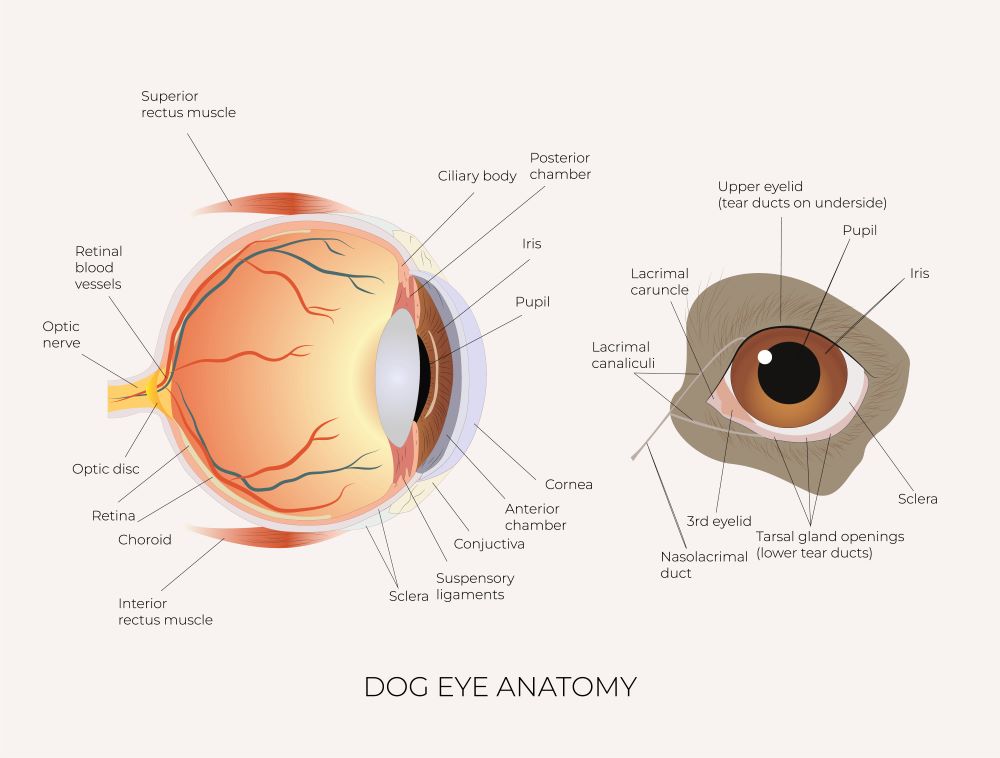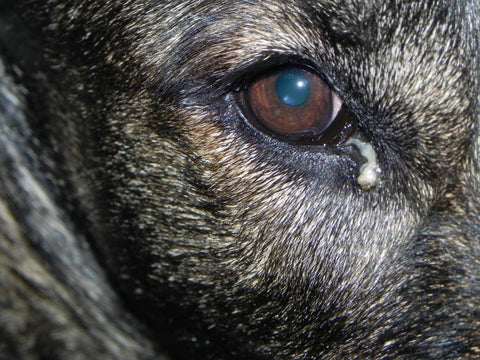Common Causes of Green Eye Discharge in Dogs Can Be Treated Without Antibiotics
Green eye discharge (or as some people say, “green eye boogers”) is a common problem in puppies and adult dogs.
Most people immediately jump to the conclusion that green or whitish discharge or mucus must mean there is an infection, but this is not always necessarily true.
The purpose of this article is to give you a better understanding of the most common causes of green eye discharge in dogs and how to address this common problem safely without unnecessary antibiotics, steroids, and other pharmaceuticals. You will also learn how to determine when it's time to see your veterinarian.
Contrary to what you may find in most online articles on this topic, green eye discharge can be caused by multiple factors:
- Processed dog food
- Post-vaccination side effects that last months or even years
- Heavy metal and toxin buildup
- Dog treats and food additives
- Household cleaning products
- Lawn and garden pesticides
- Dust, molds, and air pollution
- Milk or grains in food
- Head congestion due to excessive pulling on the collar/leash
- Undetected neck injuries
- Genetic breed predisposition and eye anatomy (Boxers, Labs, Golden Retrievers, Great Danes, and many short-nosed breeds are more likely to develop eye discharge)
- Dry eye (a condition that affects tear glands)
- Glaucoma
- Foreign body ( e.g., a piece of dust, sand, plant material)
- Bacterial infection
- Toxoplasmosis
- Tear duct (lacrimal duct) obstruction
- Environmental or food allergies
Before we dive into learning the details of addressing eye discharge in dogs, it is important to emphasize that many of the above causes can be addressed by a few simple steps or applying the Healing Cycle, a universal healing system that can be used to treat a wide variety of medical conditions.
Read this article carefully before you reach the end, where I list recommendations on how to address your dog’s eye condition.
Understanding the Types of Eye Discharge in Dogs
Your dog’s eye discharge can help you determine if your canine friend suffers from a serious eye disease or if other possible issues related to metabolism or the environment may be the reason behind it.
-
Light brown eye crusts
Small brownish crusts at the corner of your dog’s eyes that appear overnight and can be easily wiped away are the result of tears cleaning any dust or debris from the eyes. Sometimes, it can be a sign of inflammation (not an infection) that can be easily addressed by taking your dog through the Healing Cycle.
However, if you notice sticky crusts that glue the eyelids together and come with eye redness, inflammation, and discomfort, contact your veterinarian.
-
Watery eye discharge
Watery eye discharge or excessive tearing in dogs are often the result of the eye being irritated by a grain of sand, a piece of plant material or similar but it can also be a sign that the tear ducts, which drain tears, are obstructed, damaged, or too narrow.
If your dog has watery eye discharge that lasts for more than two days, this can indicate a more serious health concern including allergies, corneal wounds, blocked tear ducts, or glaucoma.

-
White-gray dry or sticky eye discharge
White-gray eye discharge can be a sign of dry eye or keratoconjunctivitis sicca (KCS), an autoimmune condition where the tear glands' ability to produce tears is diminished or absent completely. The purpose of tears is to cleanse and lubricate the eye while their absence usually leads to inflammation, corneal ulcers, and secondary infections.
If your dog has white-gray mucus around their eyes and other symptoms such as redness, inflammation, and pain, you should see your veterinarian.

-
Green or yellow eye discharge
While green or yellow eye discharge may be associated with bacterial eye infections, it can also be the body’s attempt to cleanse toxins and heavy metals from the body. Green or yellow discharge is also one of the most common vaccination side effects that can persist for a long time. Dietary imbalances or allergies may also play a role.
Addressing the above by applying the Healing Cycle, using a simple saline wash, detoxing the body with LiverTune, and administering the homeopathic remedy Thuja 30C or 200C often resolves this issue. You can find out more about the natural eye clearing protocol at the end of this blog. If the problem isn’t resolved, please see your veterinarian.
-
Bloody eye discharge
The presence of bloody eye discharge in dogs can indicate trauma to the eye, severe inflammation, or an eye tumour and requires immediate veterinary attention.
There may also be a small growth on the eyelid, which can easily get scratched and start bleeding. Please see your veterinarian immediately if your dog has bloody eye discharge.
How to Treat Your Dog’s Green, Yellowish or Purulent (puss-like) Eye Discharge
The conventional treatment approach overview
In a conventional veterinary practice, antibiotics with corticosteroids are generally overprescribed. This is undeniably done with good intentions but also the lack of understanding that eye discharge is often a mere signal that the body is toxic or out of balance.
In most cases, a prescription of steroids and antibiotics solves the problem temporarily, but it mostly recurs and becomes chronic if the underlying cause is not addressed.
As I mentioned above, one of the primary causes of green eye discharge in dogs is toxin buildup and vaccination side effects. This is very common, especially in young puppies that receive several multivalent (multi-disease) vaccines in a short span of several months.
For the body, it is no different than going through 20 to 30 infectious diseases in an extremely short period, which results in inflammation and immune system activation, eye discharge being a part of.
Holistic approach overview
From a holistic point of view, your dog’s eye discharge may be infectious, or related to other eye conditions, but most commonly it's the body’s way of cleansing and getting rid of local impurities or toxins in the system. It may also be a sign of immune system activation due to excessive vaccination or allergies.
Sadly, by the time a puppy is three to four months old, they often receive their first prescription of steroid or antibiotic eye ointment. I'm especially concerned about steroids, which are absorbed into the body, affect the adrenal glands, and suppress the immune system and healing ability. This is often the start of the chain reaction of poor health in many young dogs.
Using steroids for your dog's eye discharge can be compared to a garbage bin that is packed in more every time it starts overflowing.
This is why it's so important for you not only to understand this negative impact on the body but also have an effective yet safer natural treatment alternative.
When You Should Call the Vet: Important Info About Dog Eye Infections Or Discharge
It may surprise you but true bacterial eye infections in dogs are very rare and cleansing discharge is often mistakenly diagnosed as an eye infection.
The eye has evolved to resist bacteria and if you see eye discharge with slight inflammation of the conjunctiva when you pull the eyelid down, there is usually no need to panic.
However, if your dog seems to be in discomfort or shows signs of eye redness or discharge that doesn’t go away within a few days, seeing your veterinarian is the safest option to rule out serious health problems. Always ask questions regarding medication and why it is used.
If your dog’s greenish eye discharge just started, or your vet didn’t find any serious problems such as glaucoma, uveitis or dry eye, I suggest you give the following protocol instead of using antibiotics and steroids immediately.
8-Step Protocol for Treating Green Eye Discharge in Dogs Naturally
-
Look for any signs of a foreign body or injury in your dog’s eye.
- Rinse your dog’s eyes two to three times daily with sterile saline solution from your local pharmacy
- Give a dose of Thuja 200 C homeopathic remedy and repeat the dose in two weeks. This treatment often has an immediate eye-clearing effect and can neutralize the possible negative effects of vaccination in your dog. You can order this homeopathic remedy at Helios Pharmacy or Hahnemann Labs
- Swap your dog’s collar for a front clip, well-fitted harness and a shock-absorbing leash. Collar pressure can create head congestion, causing eye discharge.
- Do an initial 4 week cleanse with LiverTune and then ongoing for 1 week per month as part of preventive care to push toxins and heavy metals from your dog’s body.
-
Give your dog the Fab4 essentials to optimize overall nutrition and health, correct nutrient deficiencies, and boost their body's detox capacity.
- If you’re still feeding kibble, consider switching to a natural raw or cooked diet. Try the Dog Food Recipe Maker for easy-to-make, healthy recipes and watch our free Raw and Cooked Diet Course to learn more about creating a natural diet for your canine friend.
-
Boost your dog's immunity naturally and minimize vaccinations by using a safer vaccination protocol.

How Long Will It Take for Your Dog’s Green Eye Discharge to Clear?
If you follow the above treatment protocol, your dog’s eyes should clear within a few days or a couple of weeks at most, depending on the severity of the condition.
If there is no improvement within a reasonable amount of time, take your dog to be examined by your veterinarian.
Quick Review - How to Prevent Eye Problems in Dogs
The best way to prevent eye discharge and infections in dogs is to gain a holistic view of your dog’s health. Eye problems are often a ‘red flag’ that there’s a deeper health concern causing an imbalance in the body.
Here are several simple ways to protect your dog’s eye health and boost overall health and longevity (some of them are similar to the treatment steps mentioned above):
- Reduce the number of vaccines as much as possible and use titer tests to assess your dog’s immune response.
- Switch from kibble to a species-appropriate raw or cooked diet that meets your dog’s nutritional needs and supports optimal organ health.
- Improve your dog’s gut health and immune function with canine probiotics that repopulate the microbiome with beneficial bacteria and support healthy digestion and bowel movements.
- Do a semi-annual liver cleanse to eliminate toxins and heavy metals accumulated in your dog’s body.
- Use non-toxic, chemical-free flea and tick control to protect your dog’s long-term health and well-being.
- Protect your dog’s neck and throat against injuries with a natural Gentle Leash and customizable dog harness that fits their body comfortably and allows complete freedom of movement.
- Treat dietary deficiencies by supplementing your dog’s diet with all-natural minerals, fermented vitamins and Omega-3 fatty acids.
Dog Eye Discharge FAQ
-
When should I be concerned about my dog's eye discharge?
Small amounts of light brown crusts may be normal if your dog’s eyelid anatomy predisposes them to tearing. However, it may also be a sign of a health problem, obstructed tear ducts or other issues.
If your dog has eye discharge that lasts for more than a few days and is accompanied by other symptoms such as redness, inflammation, discomfort, pawing at or rubbing the eyes, sneezing, nasal discharge, and lethargy, see your veterinarian.
-
Why does my dog have green eye discharge?
Green eye discharge in dogs can be a sign of bacterial eye infection, but it can also indicate a deeper health concern caused by immune system agitation, the body's attempt to eliminate toxins or vaccination side effects.
Follow the protocol outlined above to help treat and prevent eye discharge in your dog.
-
How do I get rid of my dog’s eye discharge?
Your dog's eye discharge may often be the body's way of cleansing impurities and toxins. Switching to a natural diet, detoxing the body, and minimizing vaccines and conventional drugs can help clear eye discharge in dogs, restore balance, and support optimal organ and immune system function.
Refer to the eye-clearing protocol above for a step-by-step guide to naturally treat and prevent eye discharge and infection in dogs.
-
Why is mucus coming out of my dog's eye?
Dog eye mucus is usually a sign there is inflammation, an eye infection or the activation of the body’s cleansing process. It can also happen when dust, pollen, and impurities irritate the eye and conjunctival sac.
However, mucus can also be a sign of a more serious problem such as but not limited to dry eye (keratoconjunctivitis sicca), glaucoma, eye trauma, corneal ulcer, or eyelid growths.
Contact your veterinarian if you suspect your dog has an eye infection or other eye problem.
-
Is eye mucus normal in dogs?
Eye mucus is generally not normal as it is a symptom of inflammation, irritation, infection or a deeper issue within the eye. Eye mucus and discharge may also be a sign that the eye’s defences have been on high alert. From the physical point of view, mucus helps to remove debris and foreign objects, for example, eyelashes and hair.
If you notice that the mucus persists it may also be a sign of dry eye condition, despite it not appearing dry. When it comes to any eye conditions that persist and do not stop after applying the simple eye protocol mentioned above, the safest option is to see your veterinarian.






























